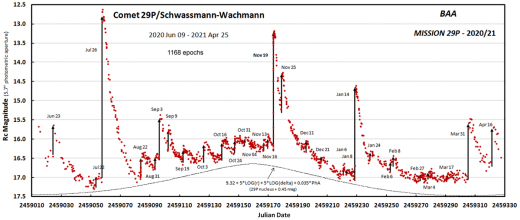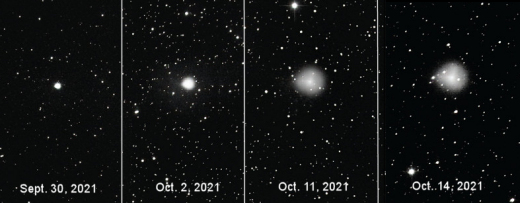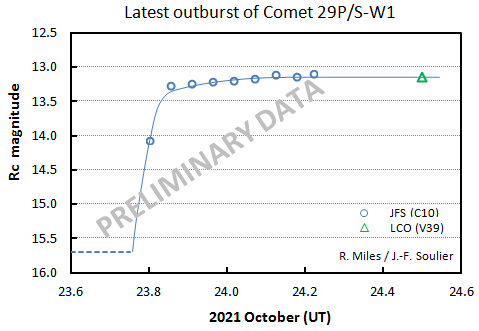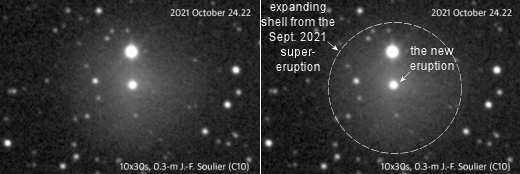Heliobas Disciple
TB Fanatic
Spaceweather.com Time Machine
spaceweather.com
A VOLCANIC COMET BLOWS ITS TOP:
So you think you know what a comet is? Think again. Comet 29P/Schwassmann-Wachmann is challenging old ideas. Astronomers call it a comet, but, really, "giant space volcano" might be a better description. It's a 60-km-wide ball of ice orbiting the Sun beyond Jupiter, and it appears to be one of the most volcanically active bodies in the entire Solar System.
Comet 29P just blew its top ... again. In late September 2021, 29P erupted four times in quick succession, blowing shells of "cryomagma" into space. Arizona amateur astronomer Eliot Herman has been monitoring the debris:
"Initially it looked like a bright compact object," says Herman. "Now the expanding cloud is 1.3 arcminutes wide (bigger than Jupiter) and sufficiently transparent for background stars to shine through."
When this object was discovered in 1927, astronomers thought they had found a fairly run-of-the-mill comet, unusual mainly because it was trapped in a nearly circular orbit between Jupiter and Saturn. 29P quickly proved them wrong as it began to erupt over and over again. Modern observations show that outbursts are happening as often as 20 times a year.
"The current outburst, which began on Sept. 25th, appears to be the most energetic of the past 40 years," says Dr. Richard Miles of the British Astronomical Association (BAA). "Within a span of only 56 hours, four eruptions took place in quick succession, creating a 'superoutburst.'"
Miles has developed a theory to explain what's happening. The "comet," he believes, is festooned with ice volcanoes. There is no lava. Instead, the volcanoes are powered by a mixture of liquid hydrocarbons (e.g., CH4, C2H4, C2H6 and C3H8) akin to those found in the lakes and streams of Saturn's moon Titan. In Miles's model, the cryomagma contains a sprinkling of dust and it is suffused with dissolved gases N2 and CO, all trapped beneath a surface which, in some places, has the consistency of wax. These bottled-up volatiles love to explode when a fissure is opened.

Above: A time series of previous outbursts from June 2020 - April 2021. These are all small compared to the current superoutburst. Source: Mission 29P.
In a seminal paper published 5 years ago, Miles studied more than a decade's worth of eruptions, and he found some patterns. The data suggest that 29P rotates every 57.7 days. The most active vents are concentrated on one side of the ice-ball in a range of longitudes less than 150 degrees wide. At least 6 discrete sources have been identified.
While most outbursts fade within a week or so, this superoutburst is still visible. The rat-a-tat-tat eruption in September boosted the comet's brightness 250-fold, and it hasn't declined much since then. With an integrated magnitude between +10 and +11, the expanding cloud is well within reach of backyard telescopes.
"Comet 29P can be seen with an 8 inch 'scope," says Herman. "In smaller instruments it will appear to be a bright dot. To resolve the cloud and photograph individual stars shining through it, I used the big half-meter iTelescope T11."
Ready see something weird? 29P is located in the constellation Auriga, easy to find high in the sky at midnight. Visit Sky&Telescope for observing tips. Also, for the latest news check out the BAA's MISSION 29P website.
.




